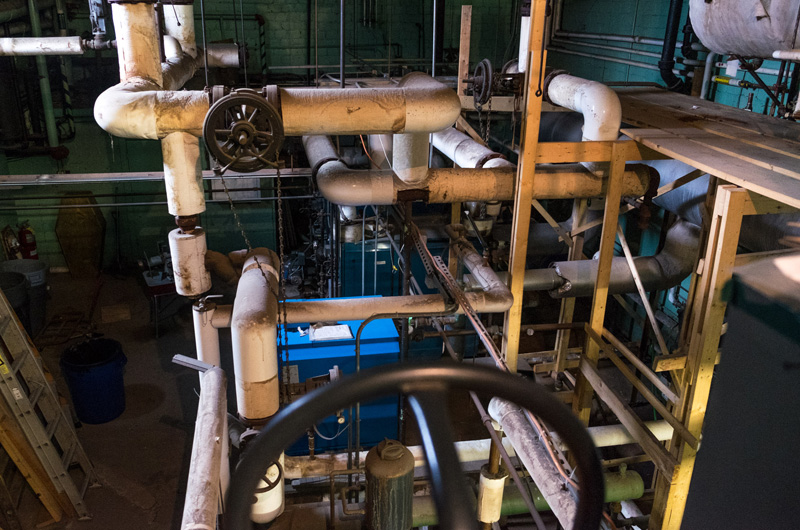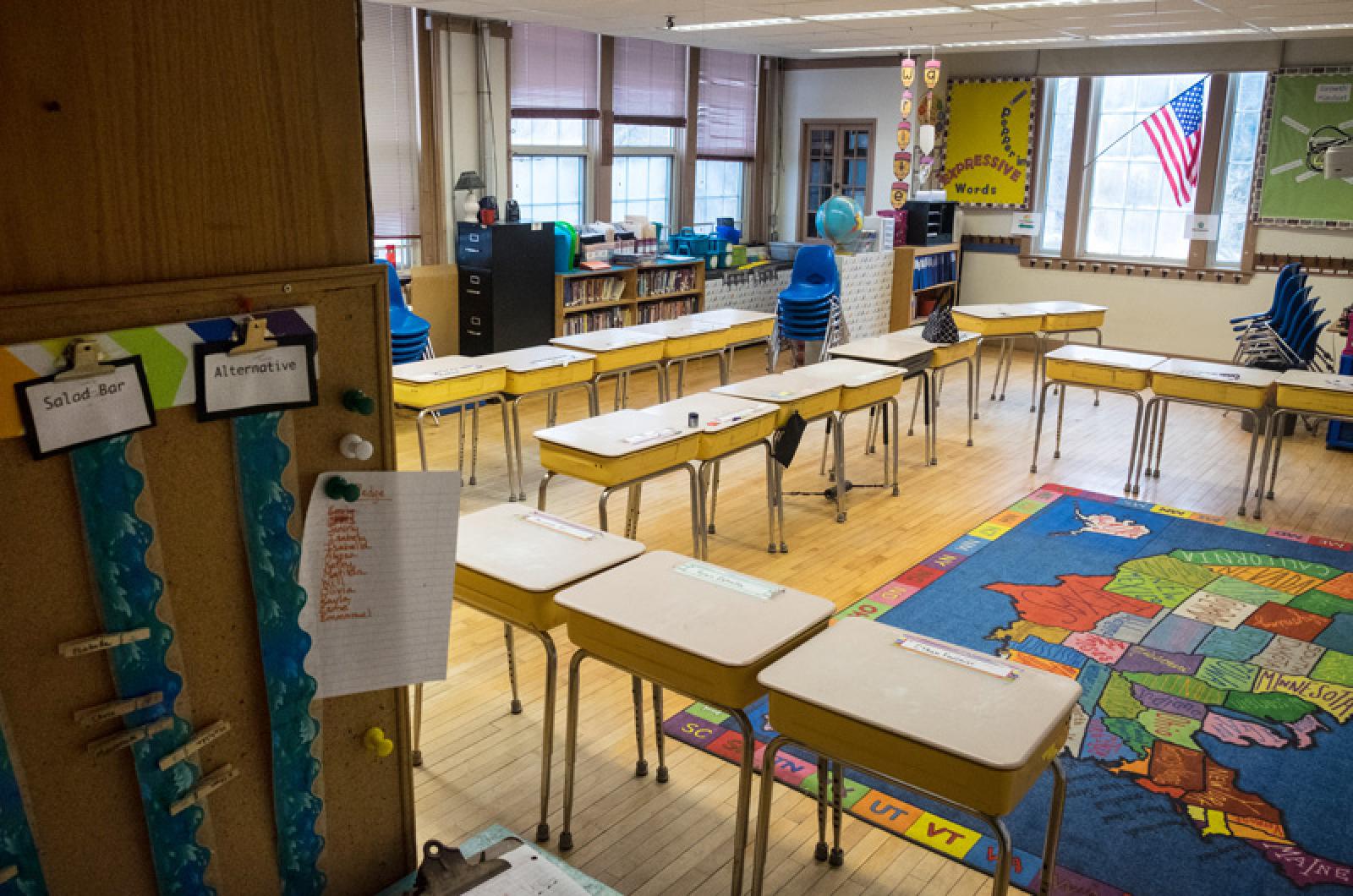After years of debate and planning on the future of the Tisbury school, the town will vote at annual town meeting on whether to fund a $46.6 million new school project.
The discussion of the school is expected to be lengthy and well-attended. The town is preparing to provide an overflow room with a deputy moderator if necessary.
“Rest assured, anyone who is going to have a question about the school is going to have an opportunity to ask that question,” Tisbury town moderator Deborah Medders said on Monday at a meeting for the school building committee. She said the committee would have 10 minutes to present the plan before she opened up the floor at town meeting.
The school project will require the town to borrow funds, so it will need a two thirds majority at town meeting to pass. It will need a simple majority in a subsequent ballot vote on April 24. The vote is also tied to a Proposition 2 1/2 override.
Following a competitive vetting process, the Massachusetts School Building Authority (MSBA) has committed to funding about $14.6 million of the project with state tax revenue, or about 31 per cent of the total projected cost, pending approval at town meeting. That leaves the town responsible for just under $32 million.
If passed, this would be the most expensive municipal project in the town’s history, according to town treasurer Jon Snyder. Mr. Snyder estimated it would cost the town an additional $13.5 million in interest to borrow its portion of the required funds. Tisbury taxpayers would see a property tax increase of $108.20 per $100,000 of property value to fund the project and would continue to see higher taxes to pay for the project for about 20 years.
The proposal calls for building a new school on the same campus as the existing building on William street in Vineyard Haven, on the east side of the lot. Classes would continue in the current school during construction. After completion of the new school (planned for August 2021), the old building would be demolished. The school building committee has hired the Boston firm Daedelus Projects, which also managed the West Tisbury Library build, for the role of project manager, as required by the MSBA.
“We’re partnering with someone who has enormous experience,” said school building committee chairman Colleen McAndrews.
The new school would be larger than the existing one, and the emphasis is on flexibility. In the design, prepared by Turowski Architects, there are moveable walls between classrooms and multiple fluid gathering areas. The boundary between indoors and outdoors also becomes permeable with art and science classrooms situated adjacent to rooftop spaces.
The building is designed for use for the next 50 years as required by the MSBA, according to lead architect Peter Turowski. There is an engineering science room, separate rooms for vocal music and instrumental music, a second-floor library and media center, and a new pre-K classroom. A community entrance would provide access to the new gymnasium and cafeteria for meetings and events. The roof would be designed to accommodate solar panels in the future, according to Mr. Turowski. And the design would allow the school to host shared services programs for students with special needs, according to superintendent Matthew D’Andrea. Those programs are currently all hosted by the Oak Bluffs, Edgartown and West Tisbury schools.
“I want to invest in the future of this Island,” Ms. McAndrews said after her most recent committee meeting. Her four children all went to the Tisbury School. “Nobody wants to see this [existing] building come down, but it has outlived its useful life as a school. A school is not meant to be a historical building. It’s meant to be a functional building.”
But among opponents of the project, the historical significance of the existing school building is a sticking point, along with questions about the planning process, and the unprecedented cost of the proposed school.
“There’s a wastefulness to removing a functioning, historic building,” said Ben Robinson, chairman of the Tisbury planning board, who also attended the school as a child.
The existing building was completed in 1929. According to Tisbury treasurer Mr. Snyder, the original school cost the town about $185,000. The town budget in 1930 was about $105,000. Enrollment included a high school and totalled more than 350 students.
A Vineyard Gazette article from 1930 describes the dedication ceremony for the school and the sense of hope the building represented to the residents of Tisbury: “The same spirit of dedication, not only of the building itself, but of future endeavor in the cause for which the building was erected, dominated the ceremony from the opening prayer... to the close.” A gymnasium was added in the late 1930s shortly after the school was built. There was another major renovation in the 1990’s with the addition of a new library, new kindergarten classrooms, and science labs. In 2002, the school began using an external modular classroom that houses many learning support services, including support for students who do not speak English as their first language and remedial reading programs.
School principal John Custer attended kindergarten at the Tisbury School in the late 1970s and stayed through eighth grade.

“I get the sentimental connection to this building,” he said in his office last week. The small meeting room outside his door now doubles as a teaching space. But he said he is confident a new building is necessary to keep up with modern education standards and methods, and that confidence largely comes from the MSBA.
“An objective group, the MSBA, a very competitive process, decided that our school needs improvement just by virtue of them accepting us into this process,” he said.
The Tisbury School applied to the state school funding program in 2014 and was rejected. They applied again in 2015 and were invited into the process early the next year. Concerns with the existing building are outlined in Mr. Custer’s application to the MSBA, dated April 2015. Much of the application focuses on overcrowding in the school.
Among critics of the project, there has been some skepticism about the existence of overcrowding when school-wide enrollment has declined since Mr. Custer first submitted his application. In October of 2014, there were 335 students at the school according to school census data provided by the administrative staff. Last October, that number was closer to 300 students. Based on enrollment projections from the MSBA, the new school has been designed for a K-8 population of 285 students.
The school will be designed to serve fewer students than the current one does, but at more than 76,000 square feet, the proposed building would be more than 30 per cent larger than the existing school.
Mr. Custer recently clarified that while general enrollment at the school has decreased, programs like English language learning support and special education have seen increases, and space is severely limited. Currently, special education lessons for all nine grades take place primarily in two rooms. Mr. Custer said the presence of three to four teachers in those spaces and multiple lessons happening at the same time can be distracting for students. The modular unit outside the building, Mr. Custer said, is not an appropriate learning space and has drawn criticism from state education authorities. There are currently more than 65 students at the school who are English learners according to school census numbers.
Mr. Custer also noted the limited capacity of the gymnasium, the stage, and the nurse’s office. The current cafeteria can accommodate just 80 students at a time, meaning children have to take rotating lunches about 20 minutes long.
As part of the MSBA process, the school building committee was required to consider alternatives including renovation of the existing building and constructing a new school at a different site. That research found that a base repair of the existing school (which would not relieve overcrowding issues) would cost about $23.5 million. An addition and renovation of the existing school with the educational programs the committee decided on was estimated to cost about $50 million.
The school committee chose to build an entirely new facility, partially to avoid disrupting students’ learning environment during construction, according to MSBA board meeting documents from last August. Concerns about environmental impacts of building at another site led the committee to choose building on the current site.
Ben Robinson said he would rather the town have the option of renovating the existing building and adjusting the proposed educational programs to lessen the cost of the project. The MSBA supports renovations and additions as well as new school construction projects, and requirements can be more flexible in addition/renovation projects than in construction of a new school. The significant cost of the project, especially as the town faces renovation needs at the town hall and discussions get underway about a campus-wide overhaul at the high school, has given many community members pause. At a meeting earlier this month, Tisbury selectmen declined to officially sponsor the warrant article for the school, with Selectman Tristan Israel confirming he is against the project.
Melinda Loberg, who represents selectmen on the school building committee, told the Gazette that she is nervous about the project. “It’s not easily predicted how this will turn out,” she said. “I think there’s very much passion and support on part of people closely affiliated with the school, faculty, and parents. But the cost is a big consideration to taxpayers. Already our tax rate is higher than any other towns on the Island.”
At public forums this week to educate Tisbury residents about the proposal, reactions ranged. At the Vineyard Haven library Tuesday evening, community members asked about science and music facilities and about projected school enrollment. They commended the school building committee for their work.
On Wednesday night at the Katharine Cornell Theatre, the crowd was more hesitant. Audience members voiced concerns about the additional costs of maintaining the new, larger school, including the hiring of an additional custodian. They asked about when the next renovations would be necessary on systems in the new building.
The MSBA requires town approval of the project within 120 days of their offer date. Mr. Snyder says the town has spent about $650,000 on planning so far. If Tisbury voters reject the project, they stand to lose MSBA funding and face starting over. Regardless of whether the town passes the project next month, school principal Mr. Custer says changes will need to happen.
“Something still will need to be done about the school,” he said.
There will be an information session presented by the League of Women Voters on Wednesday, April 4 at 7 p.m. at the Tisbury Senior Center, and on Saturday, April 7 at 10 a.m. there will be an information session in the Tisbury school gymnasium followed by student-led tours.
Budget and square footage figures in this story have been corrected to reflect the most recent estimates for the new school. Originally the story cited older estimates.








Comments (21)
Comments
Comment policy »